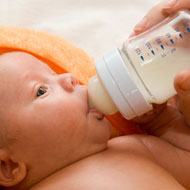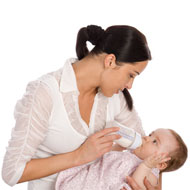Baby Bottle Feeding Tips, Formulas & Schedule
Baby bottle feeding problems are something that every mother has to deal with. This procedure requires a lot of attention and care. Here are a few baby bottle feeding tips that may prove to be helpful. Before you prepare formula, always make sure that you check for the expiry date on the can or tin.
It is also advisable to wipe the container clean before opening it, in order to prevent any dust or dirt from entering into the can. Once the formula has been prepared check its temperature. If it is too hot then give it time to cool before pouring it into the bottle.
Another thing to bear in mind while preparing the formula is the manner in which it has been prepared. Try and stay consistent as much as you can, in other words prepare it in the same manner each time.
Baby Bottle Feeding Formula
Once the formula has been emptied into the bottle, check the teat. The hole should not be too small or too big. A big hole in the teat is especially bad as the baby may choke on the formula. Similarly, a small hole may get the baby annoyed and frustrated as it may not be able to suck or draw out a sufficient amount of the liquid from the bottle. Do not feed the bay while it is asleep. A large number of babies that are fed when asleep tend to develop tooth decay. While feeding, the baby has to be positioned in the crook of your arms, in a semi upright manner or position.
This will ensure that the child does not swallow too much air.
Baby Bottle Feeding Tips
Any left over formula or milk should be discarded immediately; this will prevent the bacteria from breeding in the bottle. Rinse the bottle and the teat immediately after feeding, as this will make it easier to clean later. Make sure that both the bottle and teat are well sterilized before the babies next feeding session. There is no need to be concerned in case the baby does not take a lot of formula initially. This is because a newborn's nutritional needs are minimal. An infant that falls asleep after consuming just half an ounce of formula has most probably had enough and is content. Prepare a baby bottle feeding schedule; this will serve as a guide on when the baby needs to be fed as well as the quantity that is to be given.


